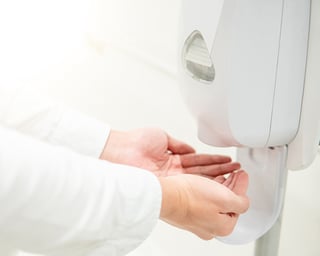Five Ways C-stores Can Upgrade Their Restrooms to Safeguard Against Coronavirus
MENOMONEE FALLS, Wis. — The COVID-19 pandemic has made consumers more aware than ever of how germs can be transmitted and raised new questions about the hygienic, safe usage of public restrooms. This will their perceptions of such facilities as businesses resume operations.
"As businesses and public establishments reopen and Americans return to using facilities, all eyes are on public restrooms," said Jon Dommisse, director of strategy and corporate development at Bradley Corp., a global manufacturer of restroom equipment. "Today's commercial washroom will be of paramount importance in providing hand washing systems and supplies, and mitigating sickness-causing germs."
There are five key considerations for keeping restrooms clean, maintained, well-equipped and prepared for a healthy hand washing experience, according to Dommisse:
1. Post signage: Operators can reinforce cleanliness with reminders about the Center for Disease Control's (CDC) guidelines about washing hands for 20 seconds, maintaining safe distance between people, throwing away paper towels and more. Bradley's recent Healthy Hand Washing Survey found that 40 percent of Americans increase hand washing when signs are posted.
"Posting updated cleaning schedules in restrooms also goes a long way in helping to reassure customers the facility is taking steps to ensure a clean environment and cares about keeping them safe," Dommisse said.
2. Offer touchless fixtures: Cross contamination in restrooms can be reduced by the use of touchless fixtures for soap, faucets, hand dryers/towels, doors and flushers.
"Under any circumstance, using touchless fixtures helps to inhibit the spread of germs in restrooms and buildings," said medical microbiologist Michael P. McCann, Ph.D., professor of biology, Saint Joseph's University. "The more we avoid restroom touchpoints, the healthier and easier our operations will be. Hands-free washrooms are a win-win for consumers and businesses."
Dommisse added, "91 percent of Americans believe it's extremely or somewhat important that public restrooms are equipped with touchless fixtures. In fact, making everything touchless is Americans' most requested improvement in restrooms."
3. Increase cleaning, sanitization and restocking: Proper and frequent cleaning and disinfection is key, especially for high-touch surfaces such as doorknobs, faucets, sinks, toilets, stall door openers and paper towel dispensers. Daily cleaning with soap and water reduces germs, dirt, and impurities on the surface and should be done frequently, especially if there is high traffic, according to the CDC.
"It's also important to disinfect surfaces to kill germs at least once daily, and more often if the restroom is busy," Dr. McCann said.
Businesses should also regularly check and restock supplies.
4. Provide trash cans and hand sanitizer near exits: "Our research shows that 65 percent of Americans use paper toweling to avoid contact with restroom doors and faucets," Dommisse said. "Keeping paper towels and waste containers near doorways can be helpful so people can throw them away upon exiting."
Installing hand sanitizer outside restrooms also lets people sanitize their hands before and after they use the restroom.
5. Prop open doors to increase visibility and minimize contact: This can provide a small window into seeing how many others are already inside the restroom, helping to limit the number and encourage social distancing. A slightly opened door also allows people to maneuver it with their elbow instead of their hands.

